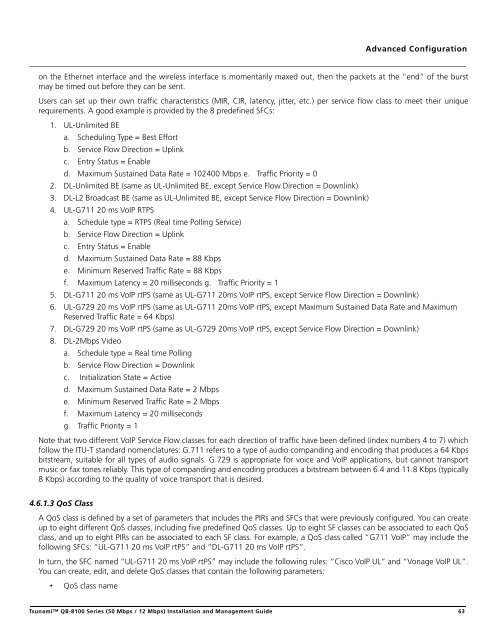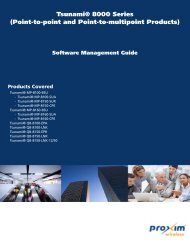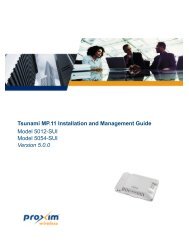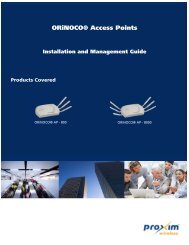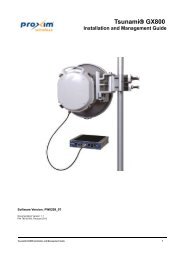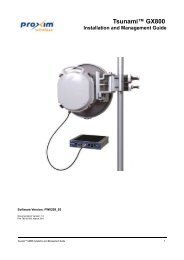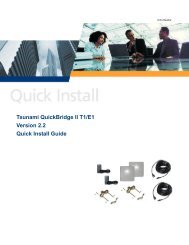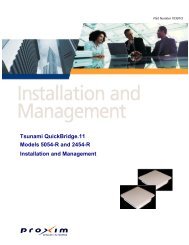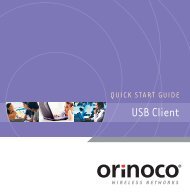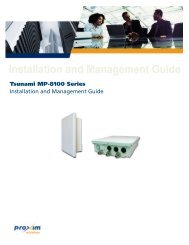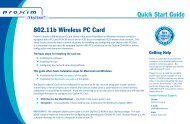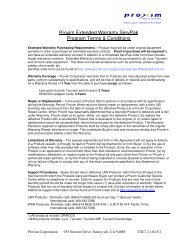Tsunami™ QB-8100 Series (50 Mbps / 12 Mbps)
Tsunami™ QB-8100 Series (50 Mbps / 12 Mbps)
Tsunami™ QB-8100 Series (50 Mbps / 12 Mbps)
Create successful ePaper yourself
Turn your PDF publications into a flip-book with our unique Google optimized e-Paper software.
Advanced Configurationon the Ethernet interface and the wireless interface is momentarily maxed out, then the packets at the “end” of the burstmay be timed out before they can be sent.Users can set up their own traffic characteristics (MIR, CIR, latency, jitter, etc.) per service flow class to meet their uniquerequirements. A good example is provided by the 8 predefined SFCs:1. UL-Unlimited BEa. Scheduling Type = Best Effortb. Service Flow Direction = Uplinkc. Entry Status = Enabled. Maximum Sustained Data Rate = 102400 <strong>Mbps</strong> e. Traffic Priority = 02. DL-Unlimited BE (same as UL-Unlimited BE, except Service Flow Direction = Downlink)3. DL-L2 Broadcast BE (same as UL-Unlimited BE, except Service Flow Direction = Downlink)4. UL-G711 20 ms VoIP RTPSa. Schedule type = RTPS (Real time Polling Service)b. Service Flow Direction = Uplinkc. Entry Status = Enabled. Maximum Sustained Data Rate = 88 Kbpse. Minimum Reserved Traffic Rate = 88 Kbpsf. Maximum Latency = 20 milliseconds g. Traffic Priority = 15. DL-G711 20 ms VoIP rtPS (same as UL-G711 20ms VoIP rtPS, except Service Flow Direction = Downlink)6. UL-G729 20 ms VoIP rtPS (same as UL-G711 20ms VoIP rtPS, except Maximum Sustained Data Rate and MaximumReserved Traffic Rate = 64 Kbps)7. DL-G729 20 ms VoIP rtPS (same as UL-G729 20ms VoIP rtPS, except Service Flow Direction = Downlink)8. DL-2<strong>Mbps</strong> Videoa. Schedule type = Real time Pollingb. Service Flow Direction = Downlinkc. Initialization State = Actived. Maximum Sustained Data Rate = 2 <strong>Mbps</strong>e. Minimum Reserved Traffic Rate = 2 <strong>Mbps</strong>f. Maximum Latency = 20 millisecondsg. Traffic Priority = 1Note that two different VoIP Service Flow classes for each direction of traffic have been defined (index numbers 4 to 7) whichfollow the ITU-T standard nomenclatures: G.711 refers to a type of audio companding and encoding that produces a 64 Kbpsbitstream, suitable for all types of audio signals. G.729 is appropriate for voice and VoIP applications, but cannot transportmusic or fax tones reliably. This type of companding and encoding produces a bitstream between 6.4 and 11.8 Kbps (typically8 Kbps) according to the quality of voice transport that is desired.4.6.1.3 QoS ClassA QoS class is defined by a set of parameters that includes the PIRs and SFCs that were previously configured. You can createup to eight different QoS classes, including five predefined QoS classes. Up to eight SF classes can be associated to each QoSclass, and up to eight PIRs can be associated to each SF class. For example, a QoS class called “G711 VoIP” may include thefollowing SFCs: “UL-G711 20 ms VoIP rtPS” and “DL-G711 20 ms VoIP rtPS”.In turn, the SFC named “UL-G711 20 ms VoIP rtPS” may include the following rules: “Cisco VoIP UL” and “Vonage VoIP UL”.You can create, edit, and delete QoS classes that contain the following parameters:• QoS class nameTsunami <strong>QB</strong>-<strong>8100</strong> <strong>Series</strong> (<strong>50</strong> <strong>Mbps</strong> / <strong>12</strong> <strong>Mbps</strong>) Installation and Management Guide 63


